This article was co-authored by Natasha Dikareva, MFA. Natasha Dikareva is a San Francisco, California based sculptor, and installation artist. With over 25 years of ceramics, sculpting, and installation experience, Natasha also teaches a ceramic sculpture workshop titled "Adventures in Clay" covering concept development, hand-building techniques, texture, and glazing techniques. Her work has been featured in solo and group exhibitions at the Beatrice Wood Center for the Arts, Abrams Claghorn Gallery, Bloomington Center for the Arts, Maria Kravetz Gallery, and the American Museum of Ceramic Art. She has taught at the University of Minnesota and the American Indian OIC School. She has been awarded the Excellence Award at the 1st World Teapot Competition, Best in Show at the 4th Clay & Glass Biennial Competition, and a Grand Prize at the American Museum of Ceramic Art. Natasha holds an MFA from the University of Minnesota and a BFA from Kiev Fine Arts College.
There are 12 references cited in this article, which can be found at the bottom of the page.
wikiHow marks an article as reader-approved once it receives enough positive feedback. In this case, 87% of readers who voted found the article helpful, earning it our reader-approved status.
This article has been viewed 210,235 times.
Many people enjoy making pinch pots because of their relatively easy construction and forgiving form. To begin, choose a clay to use. There are different clay types that have different firing requirements and can be used in different ways. Next, form the pinch pot by rolling the clay into a ball and thinning out the walls with your fingers. Let the pot dry completely before firing it or baking it. Finally, add any embellishments to the surface of the pot with paint, varnishes, or glaze.
Steps
Choosing Clay
-
1Use oven baked polymer clay. This clay is very popular with hobbyists for its durability and versatility. Once you form your pot, you can easily cure the pot by baking it in your oven. However, polymer clay is not food safe. If you make a pinch pot out of this clay, you won’t be able to eat or drink out of it.[1]
- Polymer clay can damage wooden or varnished surfaces in your home. If you choose to use this clay, cover your workspace with a towel or plastic bag.[2]
- This clay can be purchased online or at a craft store.
-
2Purchase air-drying clay. Air-drying clay cures on its own without having to be baked in the oven or fired in a kiln. You can also paint a varnish onto the surface to make it safe for dry foods. However, this type of clay can’t be submerged or filled with a liquid as it will disintegrate.[3]
- This clay can be purchased online, at a craft store, and at some professional pottery supply stores.
Advertisement -
3Buy pottery clay. If you want to make a durable, food and drink safe pinch pot, you need to use pottery clay. This kind of clay can be intimidating to beginners as you have to fire it in a kiln to cure it. However, many professional pottery supply stores also provide kiln services. Simply drop off your pottery, wait a few days, and pick it up again once it’s been fired.
- Talk to a store representative to choose a particular clay and to learn about their firing services.
- If you’re planning on glazing your pot to make it food safe, you will have to purchase a glaze as well. A store representative can help you choose the right glaze for your needs.
Forming the Pinch Pot
-
1Create a ball. Pull a tennis-ball sized chunk of clay away from your clay supply. Next, roll the chunk between your hands or against your work surface to form a ball.[4] [5] Keep the surface of the ball as smooth as possible.
- Make sure you don’t create pockets in the surface of the ball by pressing with your fingers. Instead, use your palms to mold the ball.
-
2Create an opening. Cup the ball in your hand. Next, gently press your thumb into the center of the ball to create an opening.[6] Leave at least 3/8 of an inch (1 centimeter) of clay at the bottom to form the base of the pot.
- If you accidentally pinch through the base of the pot, roll the clay into a ball again and start over.
-
3Pinch the pot. Use gentle pinching motions to thin out the walls of the pot. Work in circles to thin out the sides at the same rate. Keep pinching until the walls are as thin as you’d like them. The walls of the pot should be similar in thickness without any large divots.[7] [8] Smooth out any cracks in the clay with your fingers after you’ve finished forming the pot.
- While pinching, pay attention to the shape of your pot. Will it be a circular pot, a square-bottomed pot, or a long, tall pot?
- The walls can be as thick as you’d like them. However, make sure you don’t make them any thinner than 3/8 of an inch (1 centimeter) or they will collapse.
-
4Let the pot become “leather hard”. Set the pot in a low-traffic location and cover it with a lightweight hand towel. Let the pot dry for a few hours, checking on it periodically. When the pot is leather hard, it will be cool to the touch and firm like a block of cheese.[9]
- If the pot starts to look chalky, it is getting too dry.
-
5Smooth the surface of the pot. Once the pot is leather hard, you can smooth the surface and add embellishments.[10] Many potters prefer to use their fingers to smooth the surface of the pot, but you can also use specialized pottery tools such as wooden ribs. Additionally, you can even out the lip of the pot by cutting away any uneven areas with a craft knife. Other embellishments can include:
- Using your fingers to smooth away any marks or cracks in the surface
- Using a wooden stick to carve a pattern into the side of the pot
- Scraping a serrated metal rib against the side of the pot to create a rough texture
-
6Allow the pot to dry completely. Let the pot become “bone dry.” During this stage, the pot will be rigid, brittle, and chalky. Polymer clay and pottery clay must be bone dry before you can bake it or fire it. Otherwise, it may melt or explode.
- Be careful when handling a bone dry piece of pottery as it can break easily.
Hardening the Clay
-
1Cure oven-baked clay. Refer to your package of clay to see what temperature to set your oven to. Once your oven has preheated to the right temperature, place your pottery on a baking sheet and put it in your oven. Refer to the manufacturer instructions for cooking times and safety tips.
- Some people believe that you shouldn’t bake polymer clay in your oven because it will leave a harmful residue. However, this is a myth.[11]
- The baking sheet should not be used for food again once it’s been used for polymer clay.
-
2Dry out air-drying clay. You don’t need to cure air-drying clay in the oven or in a kiln. Instead, place a lightweight towel over the pot and set it in an undisturbed location.[12] Let it dry for five to seven days to allow it to completely harden before decorating it. If you paint the clay when it’s still wet, it won’t harden properly.
- Once it’s dry, the clay will be chalky and firm.
- It’s better for the clay to dry too long than too little.
-
3Fire pottery clay in a kiln. The firing process will cure the clay and make it rock hard. Once your pot is completely bone dry, carefully transport it to your local pottery supply store. These stores usually offer inexpensive firing services. You will be able to pick up your fired piece after a few days.
- Make sure you tell the store employee the name of the clay you used as different clays are fired to different temperatures.
Decorating the Surface
-
1Paint your oven baked polymer clay pot. You can use any kind of water-based paints, metallic pastes, chalk paint, or mica powders to decorate the surface of your pot. Once you’ve decorated it, seal the paint onto the surface of the pot with a sealing varnish.[13] Polymer clay isn’t food safe, so you don’t have to worry about choosing food safe paints or varnishes.
- Avoid using nail polish or oil based paints on your pot. They will dissolve the surface of the clay.
- These materials can be purchased at most craft supply stores. For help finding them, talk to a store representative.
-
2Decorate an air-dried pinch pot. Air dry clay can be decorated with latex and acrylic paints. If you’re planning on using your pinch pot to store or serve dried foods, you will need to varnish the surface of the clay. Purchase a food-safe professional varnish and apply four to five coats to the surface of the pot.[14]
- Acrylic paints, latex paints, and food-safe varnishes can be purchased at craft supply stores. Talk to a store representative for help finding these items.
- Follow the manufacturer instructions when applying the food-safe varnish. For example, some varnish manufacturers ask you to let the varnish dry twenty-four hours between coats.
-
3Glaze or paint pottery clay. Once your pot has been fired in a kiln, you can decorate the surface however you’d like. If you’re not going to use the pot for food or drinks, you can paint the pot with acrylic, latex, or oil-based paints. Alternatively, glaze your pot to make it food and drink safe. This will require another firing in the kiln, so talk to a pottery store representative to learn about your options.
- You will need to choose a glaze that has a similar firing temperature to your clay. Talk to a pottery store representative for help choosing a glaze.
- Never glaze the bottom of your pot. This will make it stick to the kiln shelf and ruin it.
Expert Q&A
-
QuestionHow do you keep a pinch pot from cracking?
 Natasha Dikareva, MFANatasha Dikareva is a San Francisco, California based sculptor, and installation artist. With over 25 years of ceramics, sculpting, and installation experience, Natasha also teaches a ceramic sculpture workshop titled "Adventures in Clay" covering concept development, hand-building techniques, texture, and glazing techniques. Her work has been featured in solo and group exhibitions at the Beatrice Wood Center for the Arts, Abrams Claghorn Gallery, Bloomington Center for the Arts, Maria Kravetz Gallery, and the American Museum of Ceramic Art. She has taught at the University of Minnesota and the American Indian OIC School. She has been awarded the Excellence Award at the 1st World Teapot Competition, Best in Show at the 4th Clay & Glass Biennial Competition, and a Grand Prize at the American Museum of Ceramic Art. Natasha holds an MFA from the University of Minnesota and a BFA from Kiev Fine Arts College.
Natasha Dikareva, MFANatasha Dikareva is a San Francisco, California based sculptor, and installation artist. With over 25 years of ceramics, sculpting, and installation experience, Natasha also teaches a ceramic sculpture workshop titled "Adventures in Clay" covering concept development, hand-building techniques, texture, and glazing techniques. Her work has been featured in solo and group exhibitions at the Beatrice Wood Center for the Arts, Abrams Claghorn Gallery, Bloomington Center for the Arts, Maria Kravetz Gallery, and the American Museum of Ceramic Art. She has taught at the University of Minnesota and the American Indian OIC School. She has been awarded the Excellence Award at the 1st World Teapot Competition, Best in Show at the 4th Clay & Glass Biennial Competition, and a Grand Prize at the American Museum of Ceramic Art. Natasha holds an MFA from the University of Minnesota and a BFA from Kiev Fine Arts College.
Ceramics & Sculpting Instructor Make sure the wall of your pot is as even as possible in thickness. Otherwise, when the clay dries and then fires, the particles in the thicker areas will be wet. The particles in the thinner areas will be drier, and they'll pull on the thicker areas and that will create some cracks.
Make sure the wall of your pot is as even as possible in thickness. Otherwise, when the clay dries and then fires, the particles in the thicker areas will be wet. The particles in the thinner areas will be drier, and they'll pull on the thicker areas and that will create some cracks. -
QuestionWhat is the best stage of clay for making a pinch pot?
 Community AnswerYou must use wet clay to make a pinch pot. Wet clay is fresh from the bag, easy to mold, and squishy.
Community AnswerYou must use wet clay to make a pinch pot. Wet clay is fresh from the bag, easy to mold, and squishy. -
QuestionWhat are the ingredients in the clay?
 Community AnswerEach kind of clay has a different set of ingredients. Find this information on the back of the clay package or on the manufacturers website.
Community AnswerEach kind of clay has a different set of ingredients. Find this information on the back of the clay package or on the manufacturers website.
References
- ↑ https://thebluebottletree.com/polymer-clay-safe/
- ↑ https://www.youtube.com/watch?v=Trs4JqycBKE&feature=youtu.be&t=79
- ↑ http://www.designsponge.com/2015/03/diy-clay-platters.html
- ↑ Natasha Dikareva, MFA. Ceramics & Sculpting Instructor. Expert Interview. 1 June 2021.
- ↑ http://www.ofakind.com/stories/8720-brooke-winfreys-7-steps-to-making-your-own-pinch-pots-no-wheel-required
- ↑ Natasha Dikareva, MFA. Ceramics & Sculpting Instructor. Expert Interview. 1 June 2021.
- ↑ Natasha Dikareva, MFA. Ceramics & Sculpting Instructor. Expert Interview. 1 June 2021.
- ↑ https://www.youtube.com/watch?v=KjhnLu36j4A&feature=youtu.be&t=169
- ↑ http://www.claygeek.com/ceramics-101/need-to-know-stages-of-drying-for-clay/
About This Article
To make a pinch pot, once you’ve chosen your clay, take a tennis-ball sized chunk of clay and roll it into a smooth ball. Use your thumb to make an opening in the ball and then use gentle pinching motions all around to thin the pot’s walls. It’s ok to do this in any shape you want, just be sure the walls are of uniform width. Let the pot dry until it’s “leather-hard,” which may take a few hours. Then smooth out the surface and add patterns or textures if you want. If you want to learn how to decorate your pinch pot after it dries, keep reading the article!
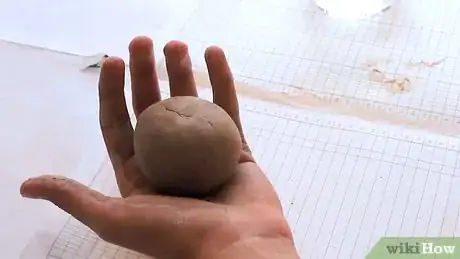
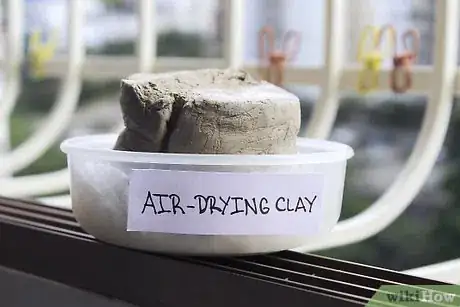
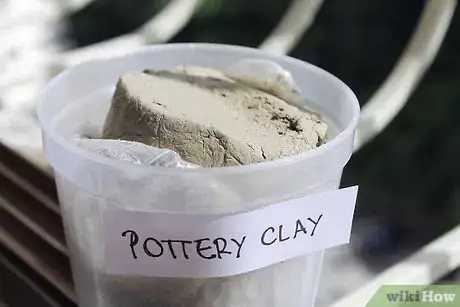
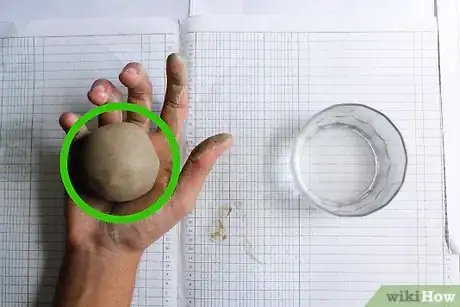

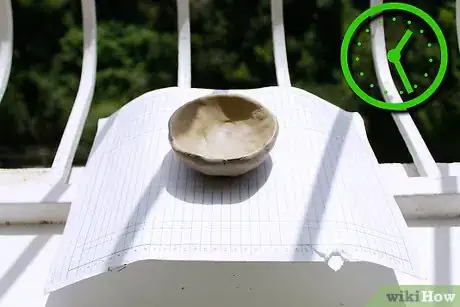
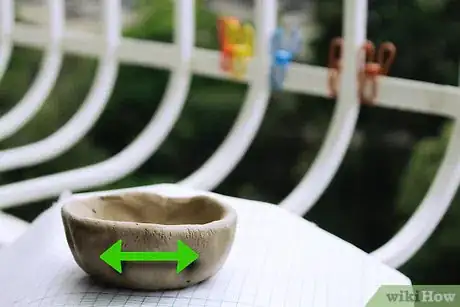
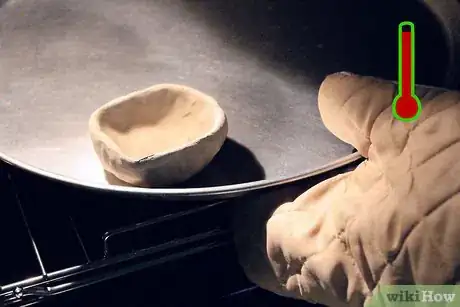
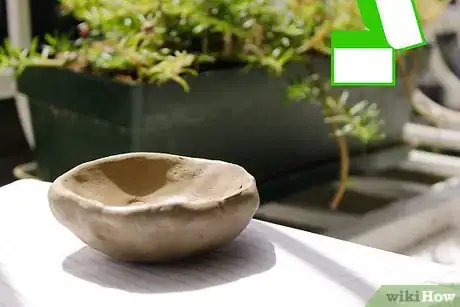

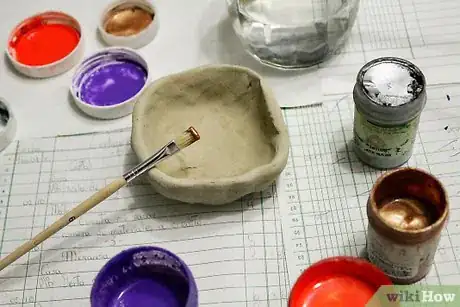
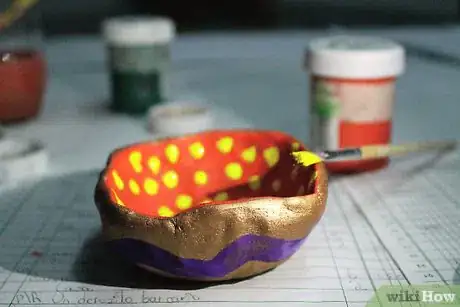







-Oven-Step-15.webp)















































